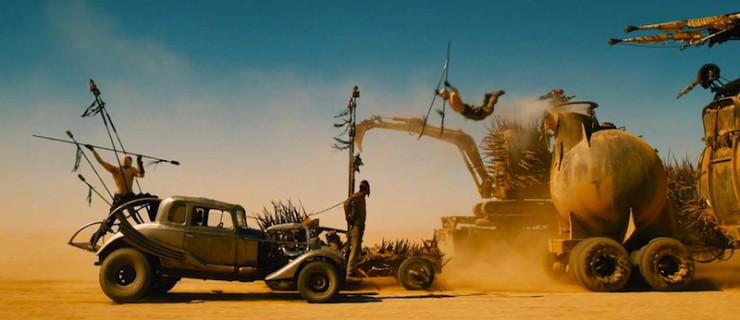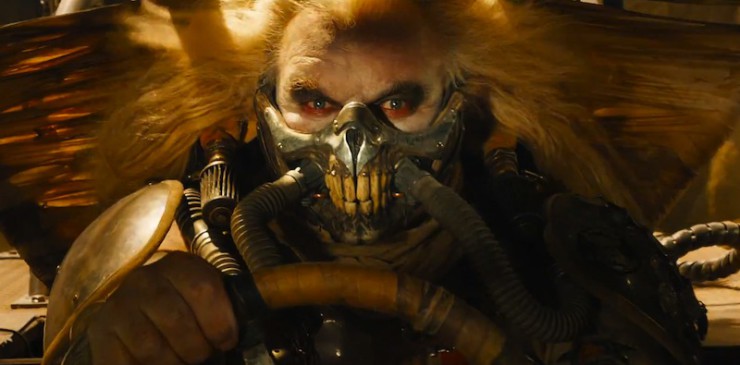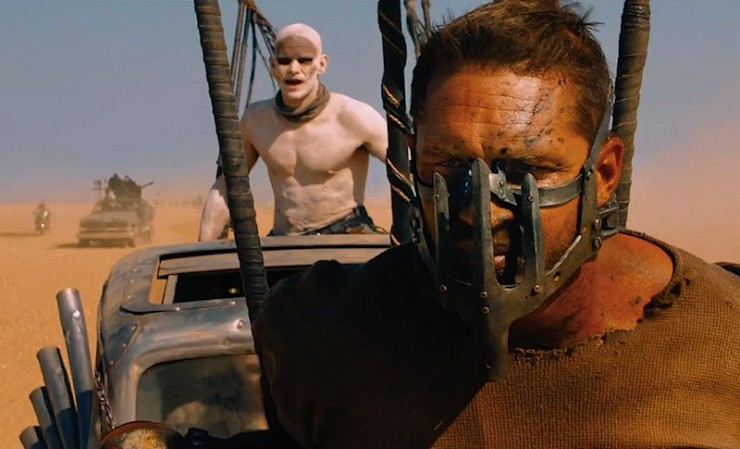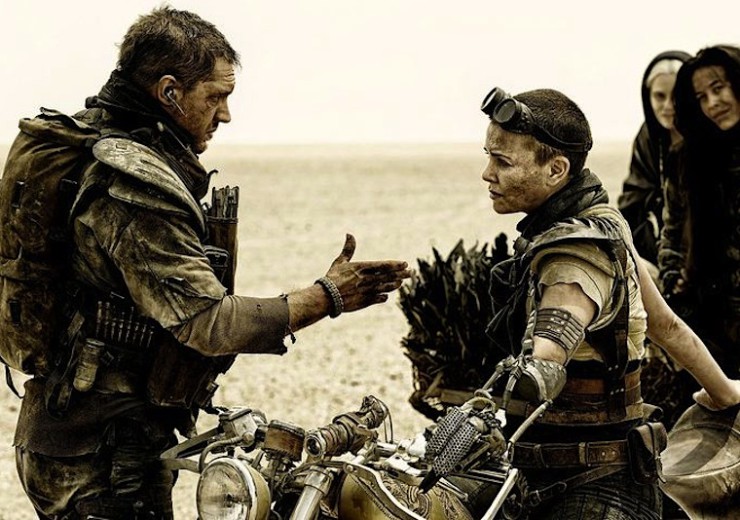The first half hour of Mad Max: Fury Road may be the greatest action movie I’ve ever seen. But then the film keeps going, keeps piling on more cars and more explosions and more perfectly choreographed fight scenes, and quickly becomes one of the best movies I’ve ever seen, period. Really this review should just be me writing GO SEE IT WHAT ARE YOU DOING TELL YOUR BOSS YOU’RE SICK AND GET YOUR ASS TO A THEATER RIGHT NOW, because honestly, anything less is unethical on my part.
Now to give you a sense of where I stand: I like Mad Max alright, I loooooove The Road Warrior, and I’m really fond of Beyond Thunderdome. I was raised on a steady diet of Men with No Name, Cops on the Edge, and Cars That Explode For No Reason, and Hot Fuzz is in my Permanent Top Ten. In my mind, I am pointing my gun and shooting it into the air, while a car goes off a cliff behind me, pretty much all the time.
This movie felt like home to me.
The theater was pretty full (mostly dudes) and everyone fell completely silent as the film opened. This did not last. The action and stunts on display are extraordinary, and people cheered, applauded, and at one point yelled “What the fuck!“—trust me, you’ll know where— and applauded when the credits rolled. When the stunt people’s names came up, a lot of people started cheering all over again. As we came out a guy asked how it was, and we replied in sounds that approximated language. “I’ve waited 30 years for this,” he said. It was worth it.
Director George Miller has paced the movie perfectly—giving us a few scattered quiet moments amongst the action to make sure we don’t all asphyxiate. But then the battle music cues up again before you’ve quite caught your breath… There are lots of references to the old films—I’m not going to give any away cause it’s more fun to spot them yourselves— but they range from the sweet to the truly, twistedly ironic. Tom Hardy is fantastic as Max. He makes him maybe slightly more likable than Mel Gibson, but without ever making him cuddly, and he does a fun parody of Mel’s voice that gradually shades into his own interpretation. Charlize Theron is both believably tough and believably wounded, but, unlike Max, she doesn’t come out and tell us what’s been done to her. Hardy and Theron act with their eyes, and tell you their whole life stories…but they also keep those stories internal. It’s action that counts, and you can watch their relationship by tracking their body language.
The action sequences are, truly, seriously, some of the best I’ve ever seen. They are perfectly choreographed in the way, say, an old Jackie Chan fight is—you can always tell where everyone is. Weapons have real weight and heft, injuries matter, and physics is the hideous maniac that rules over it all. But more importantly, the action sequences are exhilarating. Anyone who saw Thunderdome and felt disappointed in its single car chase sequence will be pleased to learn that this film is almost entirely car chase. (There are no exits on Fury Road!) Since the action sequences serve as character development and plot movement simultaneously, Miller doesn’t need to stop to explain anything, and he takes this as an opportunity to try new things in each sequence. From flames to pole jockeys to bolt-cutters to chainsaws, each new battle introduces inventive weaponry and higher stakes.
So to give you a basic premise, Immortan Joe (the jaunty fellow in the tooth-mask) somehow got control of the only clean well in the area. He metes out small amounts of water to a community of very damaged and irradiated people, and also runs a car-based religious cult. He regularly has Imperators—drivers—raid the gasoline town down the road. He lives in a mountain citadel well above his followers, and trains groups of WarBoys: white-painted child soldiers who are raised to believe that dying in battle will send them straight to Valhalla. The basic plot is simple (skip this next sentence if you want to go in completely blind) Charlize Theron’s Imperator Furiosa goes on a fuel run that’s actually a freedom ride. She smuggles the slave “wives” of cult leader Immortan Joe out with her, in the hopes of taking them to “The Green Lands.” Max ends up along for the ride, and has to decide whether to help them. (It’s basically an explosion-filled version of Unbreakable Kimmy Schmidt.) The car culture of the original trilogy has been elevated (believably I think) into a full-on religion. A temple houses a pyramid made of removable steering wheels, and the Warboys genuflect before it as part of their battle preparation. They also spray paint their teeth silver, so they can be truly “chrome” and “shiny” when they meet their fellow fallen warriors in Valhalla.
There are those saying that Max is essentially pushed out of his own movie and upstaged by Imperator Furiosa, but I’m left wondering if those people have actually seen a Mad Max movie. Max is never the center of these films. He’s also essentially passive. He becomes Mad Max in the first place as a response to tragedy. He seeks vengeance because he and his family are acted upon. In The Road Warrior, he only helps Refinery Town to get his car back. In Thunderdome, he only enters into a deal with Auntie to get his stuff back (again) and he only helps Savannah to rescue her and her friends from certain death. He’s never the active party—Max is essentially, reactionary. Fury Road is actually unique in the series because it actually gives him multiple choices to make. For the first time in the series, Max gets the opening narration. He’s telling his own story for once, rather than having those he saves tell it for him, and, ultimately, he gets to decide who he is.
So far, the summer 2015 movie season is all about consent. First, we had the various monsters of Age of Ultron, two of whom, Banner and Widow, had basic rights of choice taken away from them. (Banner can’t always control The Hulk, and Widow’s training program took harsh measures to turn her into a superspy and soldier instead of a human.) Now we have Fury Road, which is about sexual slavery, child soldiers, religious cults, and whether anyone in a post-apocalyptic wasteland has the right to make their own choices. The trauma that each of these characters has suffered is evident, and the film doesn’t downplay it or shy away from it, but it also chooses to tell a story of survival. This magnificent two-hour car chase is also a story of people healing.
The other underlying theme in the series is the nature of “home.” If you’ll recall the second chorus line of “We Don’t Need Another Hero,” Tina Turner’s immortal song: “We don’t need to know the way home.” Each of the Mad Max films revolves around this idea. In the first, Max leaves his home, and it’s while he and his wife are traveling that they are terrorized by Toecutter’s gang. In The Road Warrior, the refinery town wants to pack up and seek out a place they’ve learned about through a travel brochure. And obviously in Thunderdome, Savannah Nix wants to lead her tribe away from their canyon paradise, and back into the city, thinking that that’s the way to restore civilization. Here the “wives” want to get away from the citadel to choose the way their children will grow up, far away from Joe’s warrior cult. Furiosa has a home she was taken from. Max has a home that was destroyed. Can they start over? Is it possible to find home, or hope, in a post-apocalyptic wasteland?
Some reviewers have called these women Joe’s wives, but they’re no more wives than the children kidnapped by Boko Haram. They’re slaves. Their bodies are commodities, and they’re used as such, as are Max and all the Warboys. This runs throughout the film—there is no giant hero speech here, but what this film is truly about is a group of people fighting for the right to be human. Max has never been a Mary Sue, and neither is Furiosa, and neither are the wives. People are believably battling for survival in a harsh landscape, against brutal people.
Now giant thematic stuff aside, I want to make it clear that this movie is fun. Miller’s sick humor pops up again and again, and have I mentioned the action? It’s primarily real people doing this shit. There’s very little CGI, and all the fights and explosions have real weight.
Finally, just to get this conversation out of the way: Is it feminist?
Max Max: Fury Road treats its female and male characters with equal agency. So fuck yes it’s feminist.
Leah Schnelbach maybe didn’t mention this but she loved this movie, and she thinks you should go see it!













